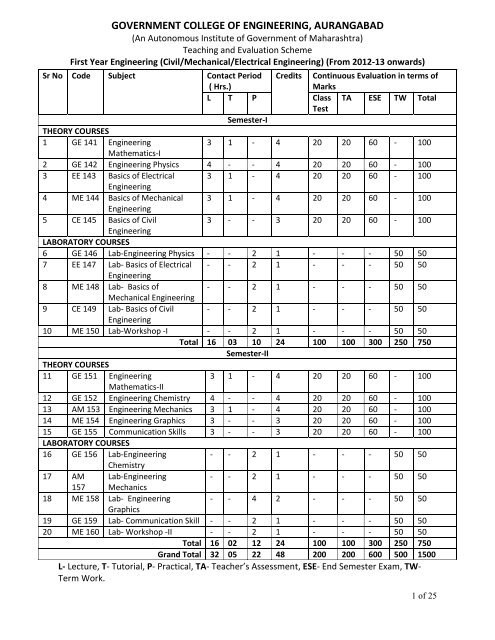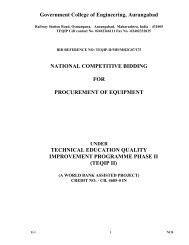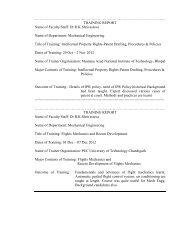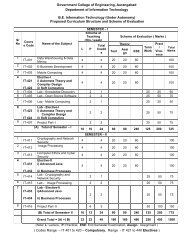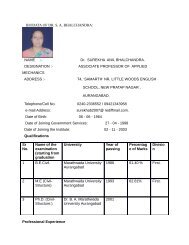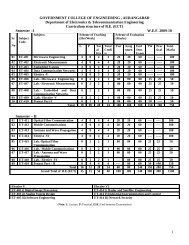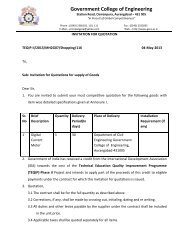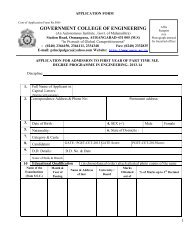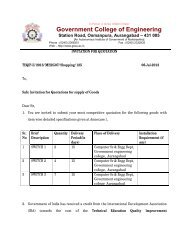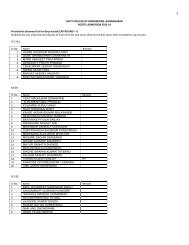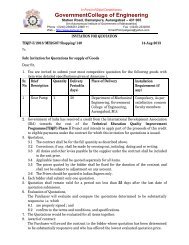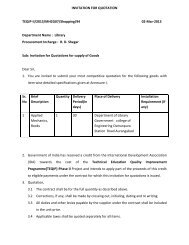First Year of Engineering - Government College Of Engineering ...
First Year of Engineering - Government College Of Engineering ...
First Year of Engineering - Government College Of Engineering ...
- No tags were found...
You also want an ePaper? Increase the reach of your titles
YUMPU automatically turns print PDFs into web optimized ePapers that Google loves.
Structure for <strong>First</strong> <strong>Year</strong> <strong>Engineering</strong> (E&TC, CSE and IT) from academic year 2012-13Sr No Code Subject Contact Period( Hrs.)Credits Continuous Evaluation in terms<strong>of</strong> MarksL T P Class TA ESE TW TotalTestSemester-ITHEORY COURSES1 GE 141 <strong>Engineering</strong>3 1 - 4 20 20 60 - 100Mathematics-I2 GE 152 <strong>Engineering</strong> Chemistry 4 - - 4 20 20 60 - 1003 AM 153 <strong>Engineering</strong> Mechanics 3 1 - 4 20 20 60 - 1004 ME 154 <strong>Engineering</strong> Graphics 3 - - 3 20 20 60 - 1005 CE 145 Basics <strong>of</strong> Civil3 - - 3 20 20 60 - 100<strong>Engineering</strong>LABORATORY COURSES6 GE 156 Lab-<strong>Engineering</strong> - - 2 1 - - - 50 50Chemistry7 AM Lab- <strong>Engineering</strong> - - 2 1 - - - 50 50157 Mechanics8 ME 158 Lab- <strong>Engineering</strong> - - 4 2 - - - 50 50Graphics9 CE 149 Lab- Basics <strong>of</strong> Civil - - 2 1 - - - 50 50<strong>Engineering</strong>10 ME 150 Lab-Workshop-I - - 2 1 - - - 50 50Total 16 02 12 24 100 100 300 250 750Semester-IITHEORY COURSES11 GE 151 <strong>Engineering</strong>3 1 - 4 20 20 60 - 100Mathematics-II12 GE 142 <strong>Engineering</strong> Physics 4 - - 4 20 20 60 - 10013 EE 143 Basics <strong>of</strong> Electrical 3 1 - 4 20 20 60 - 100<strong>Engineering</strong>14 ME 144 Basics <strong>of</strong> Mechanical 3 1 - 4 20 20 60 - 100<strong>Engineering</strong>15 GE 155 Communication Skills 3 - - 3 20 20 60 - 100LABORATORY COURSES16 GE 146 Lab-<strong>Engineering</strong> - - 2 1 - - - 50 50Physics17 EE 147 Lab-Basics <strong>of</strong> Electrical - - 2 1 - - - 50 50<strong>Engineering</strong>18 ME 148 Lab- Basics <strong>of</strong>- - 2 1 - - - 50 50Mechanical<strong>Engineering</strong>19 GE 159 Lab- Communication - - 2 1 - - - 50 50Skill20 ME 160 Lab- Workshop-II - - 2 1 - - - 50 50Total 16 03 10 24 100 100 300 250 750Grand Total 32 05 22 48 200 200 600 500 1500L- Lecture, T- Tutorial, P- Practical, TA- Teacher’s Assessment, ESE- End Semester Exam, TW-Term Work2 <strong>of</strong> 25
GE141: <strong>Engineering</strong> Mathematics-ITeaching SchemeEvaluation SchemeLectures 3 Hrs/Week Test 20 MarksTutorials 1 Hr/Week Teacher Assessment 20 MarksTotal Credits 4 End-Semester Examination 60 MarksPrerequisite:Origin <strong>of</strong> Complex numbers, Algebra <strong>of</strong> complex numbers, Forms <strong>of</strong> complex numbersCourse Objectives:To equip students withadequate exposure to basics <strong>of</strong> engineering mathematics so as to enable them to visualize theapplications to engineering problems in their respective programmesOutcomes expected:After studying the subject the students should be able to1. Simplify complex number expressions and find the complex roots <strong>of</strong> algebraic equations2. Solve the system <strong>of</strong> linear equations using reduction (rank) method3. Compute Eigen values and Eigen vectors <strong>of</strong> a matrix and use them to compute powers orexponential <strong>of</strong> matrix4. Find the higher order derivatives <strong>of</strong> a function <strong>of</strong> single variable5. Formulate the n th order differential equation from general solution6. Expand function <strong>of</strong> single variable in powers <strong>of</strong> x7. Determine convergence <strong>of</strong> a power series using ratio test, comparison test8. Find partial derivatives <strong>of</strong> explicit, implicit function <strong>of</strong> more than one9. Variable and to apply the concept <strong>of</strong> partial derivatives to find the stationary values <strong>of</strong>function <strong>of</strong> two, three variable10. Establish functional dependence amongst the functions <strong>of</strong> two /three11. variables using the concept <strong>of</strong> JacobianUNIT-1UNIT-2UNIT-3UNIT-4Complex NumbersDe Moivre’s theorem, Applications <strong>of</strong> De’ Moivre’s theorem:To find roots <strong>of</strong>complex number ,Roots <strong>of</strong> polynomial equations, Expansion <strong>of</strong>Circular functions, Hyperbolic functions,Logarithm <strong>of</strong> complex numbers, Separation <strong>of</strong> complex numbers into real andimaginary parts.MatricesRank <strong>of</strong> a matrix, Normal form <strong>of</strong> matrix, Echelon form <strong>of</strong> matrix, Algebraicsystem <strong>of</strong> m linear equations in n unknowns (Homogeneous and nonhomogeneous),Linear dependence and independence <strong>of</strong> vectors, Eigen valuesand Eigen vectors, Cayley-Hamilton theorem(Without pro<strong>of</strong>) and itsapplications.Successive Derivativesn th order ordinary derivatives <strong>of</strong> elementary functions, Leibnitz’s rule <strong>of</strong>derivatives <strong>of</strong> product <strong>of</strong> two functions, Expansion <strong>of</strong> function in power series,Taylor series, Maclaurin’s series, Convergence <strong>of</strong> series, Range <strong>of</strong> convergence<strong>of</strong> power series, Test for convergenceRatio test. Comparison test.Partial Derivatives3 <strong>of</strong> 25
UNIT-5Text Books:-<strong>First</strong> and second order Partial derivatives,, Partial derivatives <strong>of</strong> implicit andcomposite function, Total Derivative <strong>of</strong> a function, Euler’s theorem onhomogeneous functions, Change <strong>of</strong> independent variables.Unit-V: Applications <strong>of</strong> derivatives:-Limits <strong>of</strong> functions using L’Hospital’s rule, Jacobian, Partial derivatives usingJacobian, Functional dependence, Maxima and minima <strong>of</strong> functions <strong>of</strong> twovariables. Error and Approximation.1. A Text Book <strong>of</strong> engineering Mathematics (Vol.1 &2) _P.N.Wartikar & J.N.Wartikar,PuneVidhyarthi Griha Prakashan, Pune.2. Advanced <strong>Engineering</strong> Mathematics Erwin Kreyszig, Willey Eastern Ltd. Mumbai.3. <strong>Engineering</strong> Mathematics-A Tutorial Approach by Ravish R Singh, Mukul Bhatt.Reference Books:-1. Higher <strong>Engineering</strong> Mathematics by B. S. Grewal, Khanna publication, New Delhi.2. Advanced <strong>Engineering</strong> Mathematics-H. K. Dass, S. Chand and Sons.Advanced <strong>Engineering</strong> Mathematics Michael Greenberg,2/e, PearsonGE142: <strong>Engineering</strong> PhysicsTeaching SchemeEvaluation SchemeLectures 4 Hrs/Week Test 20 MarksTutorials Teacher ‘s Assessment 20 MarksTotal Credits 4 End-Semester Examination 60 MarksPrerequisite: Basic principles <strong>of</strong> Physics <strong>of</strong> Junior <strong>College</strong> levelCourse Objectives:The main objective <strong>of</strong> this syllabus is to expose students to basic physics with a view toprovide deeper insight in understanding <strong>of</strong> engineering courses,1. awaken them to understand latest developments in engineering and technology ,2. provide the basic concept to resolve many engineering and technological problems ,3. to enable them to work in inter-disciplinary areas, having potential <strong>of</strong> new technologies and4. To motivate the students through practical examples that demonstrates the role <strong>of</strong> physics inprogress <strong>of</strong> engineering disciplines so as to inculcate the interdisciplinary academicenvironment.Course outcomes :-Students will be able to1. apply knowledge <strong>of</strong> mathematics, science, and engineering2. understand latest developments in <strong>Engineering</strong> and Technology.3. work in inter-disciplinary areas, having potential <strong>of</strong> new technologies4. motivate through practical examples that demonstrate the role <strong>of</strong> Physics in5. progress <strong>of</strong> engineering disciplines so as to inculcate the inter-disciplinary academicenvironment6. gain knowledge <strong>of</strong> contemporary issues in <strong>Engineering</strong> Physics.UNIT-1Motion <strong>of</strong> Electron in uniform electric and magnetic field(parallel andperpendicular field),e/m by Thomson’s method, Electron Refraction, Electrostaticand Magneto-static focusing, Electron microscope, block diagram and4 <strong>of</strong> 25
Magnetic properties <strong>of</strong> materials-Review <strong>of</strong> basic formulae, Magneticsusceptibility, Classification <strong>of</strong> dia, para and ferromagnetic materials, Langevin’sTheory <strong>of</strong> dia and para magnetism(only classical treatment),Ferromagneticdomains ,Hysteresis in ferromagnetic materials, S<strong>of</strong>t and Hard magneticmaterials, Applications.UNIT-6 Definitions:velocity,frequency,wavelength,intensity,loudness(expressions),timber <strong>of</strong> sound,Reflection <strong>of</strong> sound, Echo, Reverberation, Reverberation time, Sabine’sformula(with derivation),Remedies over reverberation, Absorption <strong>of</strong> sound,Absorbent materials, Condition for good acoustic <strong>of</strong> the building, Noise-itseffect and remedies.Ultrasonics-Production <strong>of</strong> ultrasonics by piezo-electric and magnetostrictionoscillator, Detection <strong>of</strong> ultrasonics,<strong>Engineering</strong> applications <strong>of</strong> ultrasonics-nondestructive testing,cavitations,measurement <strong>of</strong> guage.Nano Physics- Introduction, Properties <strong>of</strong> Nanoparticles, Carbon Nanotubes,Synthesis <strong>of</strong> Nanoparticles, Applications <strong>Of</strong> Nanotechnology.Text Books:-1. <strong>Engineering</strong> Physics,Malik and Singh,Mc Graw Hill Publication2. <strong>Engineering</strong> Physics,Avadhanulu,Kshirsagar,S.Chand Publications3. <strong>Engineering</strong> Physics,Gaur ,Gupta ,Dhanpat Rai and Sons Publications4. <strong>Engineering</strong> Physics,K.Rajgopal,Prentice Hall <strong>of</strong> India Pvt.Ltd.5. Applied Physics,P.K.Mittal,I.K.International New DelhiReference Books:-1. Fundamental <strong>of</strong> Physics,Resnic and Halliday,John Wileyand Son Publications2. Laser and non-linear optics,B.B.Land,Oscar Publications3. Principles <strong>of</strong> Physics,Serway and Jewett,Saunders <strong>College</strong> Publications4. Optics,Ajoy Ghatak,Tata-McGraw Hill Publications(Third Edition)5. Optics,Eugene Hecht,Pearson Education,LPE,7 th Edition6. Fundamentals <strong>of</strong> Optics,Jenkin and White,Mc Graw Hill Publication(4 th Edition)7. Elements <strong>of</strong> Material Science and <strong>Engineering</strong>,L.H.Van vlack,Prentice Hall Publication(6 th Edition)8. LASERS Theory and Applications,K.Thygrajan,A.K.Ghatak,Macmilan India Ltd.9. Physics For Scientists And Engineers with Modern Physics,Serway and Jewett,Thomson/CengageLearning,New Delhi (7 th Edition)10. http://www.npatel.iitm.ac.in/courses/Webcoursecontents/IIT%20Guwahati/engg.physics/index-cont.htm11. http://science.howstuffworks.com/laser1.htm12. http://physics-animations.com/physics/English/optics.htm13. http://physics-animations.com/physics/English/waves.htm14. http://www.epsrc.ac.uk15. http://www.pitt.edu/~poole/physics.html/#light16. http://de.physnet.net/PhysNet/Optics.htmlEE 143 Basics <strong>of</strong> Electrical <strong>Engineering</strong>Teaching SchemeEvaluation Scheme6 <strong>of</strong> 25
Lectures 3 Hrs/Week Test 20 MarksTutorials 1 Hr/Week Teacher’s Assessment 20 MarksTotal Credits 4 End-Semester Examination 60 MarksPrerequisites: - Std. 12 th Mathematics and PhysicsCourse Educational Objectives:The objectives <strong>of</strong> this course are to1. Explain basic laws & theorems <strong>of</strong> electrical networks2. Explain fundamentals <strong>of</strong> magnetic circuits and alternating current circuits3. Apply knowledge <strong>of</strong> magnetic circuits to electrical machines4. Illustrate electrical wiring fundamentals and safety measuresCourse Outcomes:Students will be able to1. Demonstrate knowledge <strong>of</strong> circuit analysis using various basic laws andtheorems <strong>of</strong>electrical circuit2. Demonstrate knowledge <strong>of</strong> magnetic circuit3. Demonstrate and understand definition and relationship <strong>of</strong> various ACcircuits4. Demonstrate and understand the operations <strong>of</strong> Transformers, DC motors,Induction motorsand their applications5. Demonstrate and understand the electrical wiring installationsUNIT-1a) DC Circuits: Kirch<strong>of</strong>f’s laws, Source conversion, series and parallel circuit, currentand voltage division rule, Delta-star and star-delta conversion, Node voltage andMesh current methods, Superposition theorem, Thevenin’s and Norton’stheorems, Maximum power transfer theorem, (Numericals limited to two sources)b) Charging and discharging <strong>of</strong> capacitor, Time constant for RC circuitUNIT-2a) Electromagnetic Induction: Faraday’s laws, statically and dynamically inducedemf, self and mutual inductance, coefficients <strong>of</strong> coupling, dot convention,inductance in series and parallelb) Magnetic Circuits: Terms related with magnetic circuits, Magnetization curve,Magnetic leakage and fringing, Leakage coefficient, Series and parallel magneticcircuits, Magnetic hysteresis, Hysteresis and eddy current lossC) Rise and decay <strong>of</strong> current in inductive circuit, Time constant for RL circuitUNIT-3a) Single phase AC Circuits: Concept <strong>of</strong> single phase supply, Terms related with A.C.quantities, pure resistive, inductive and capacitive circuits, Complex and phasorrepresentation <strong>of</strong> AC quantities, series and parallel circuits, resonance in series andparallel circuits, Q-factor <strong>of</strong> coilb) Three phase AC Circuits: Concept <strong>of</strong> Three phase supply, star and deltaconnections, line and phase values, solution <strong>of</strong> balanced three phase circuits,phasor diagram7 <strong>of</strong> 25
UNIT-4UNIT-5Principle <strong>of</strong> operation, constructional details, types and applications <strong>of</strong> singlephase TransformerSingle phase and three Induction motors, DC motors (Descriptive treatment only)Electric Wiring installations: Types <strong>of</strong> insulated wires & wiring systems, concept <strong>of</strong>fuses, MCBs, ELCBs, etc. in wiring installations, concept <strong>of</strong> earthing, energy billcalculations, study <strong>of</strong> different lampsText/Reference Books:1) Leonard Bobrow ’’Fundamentals <strong>of</strong> Electrical <strong>Engineering</strong>” ,Oxford University press2) Vincent Del Toro ,”Principles <strong>of</strong> Electrical <strong>Engineering</strong> “, Printice Hall.3) D.P. Kothari, I.J Nagrath ,”Basic Electrical <strong>Engineering</strong> “Tata McGraw Hill4) M.S.Naidu, S.Kamakshaiah ,”Introduction to Electrical <strong>Engineering</strong>” Tata McGraw Hill5) J.P.Tiwari,”Basic Electrical <strong>Engineering</strong> “New Age Publication6) Joseph Administer,”Schaum’s outline <strong>of</strong> Electric circuits”, Tata McGraw HillME144: Basics <strong>of</strong> Mechanical <strong>Engineering</strong>Teaching SchemeEvaluation SchemeLectures 3 Hrs/Week Test 20 MarksTutorials 1 Hr/Week Teacher Assessment 20 MarksTotal Credits 4 End-Semester Examination 60 MarksCourse Objectives:To expose the students to the general principles and systems in Mechanical <strong>Engineering</strong>.Outcomes expected:1. Attain basic knowledge related to mechanical engineering systems2. Able to solve numerical problems on fundamental <strong>of</strong> thermodynamics, laws <strong>of</strong> thermodynamics,energy interaction and steady state energy flow3. Able to measure pressure, temperature and related numerical4. Understand working <strong>of</strong> two stroke and Four stroke IC engine, diesel and petrol engine,subsystems <strong>of</strong> IC engine, Refrigeration, Non conventional energy sources5. Uses <strong>of</strong> drives like belt pulley, gear chain etc, bearings, couplings6. Understand various manufacturing and machining processes7. Able to understand functioning and component diagram <strong>of</strong> lathe and milling machineUNIT-1UNIT-2Fundamentals <strong>of</strong> Thermodynamics,Pressure and pressure measurement(Analytical treatment), Temperature, Zeroth law <strong>of</strong> thermodynamics, Measurement <strong>of</strong>temperature, Thermometer, forms <strong>of</strong> energy, Work transfer, P-dV work, other forms<strong>of</strong> worktransfer, Heat Transfer, Concept <strong>of</strong> Specific Heat, Sensible Heat, Latent Heat<strong>First</strong> law <strong>of</strong> Thermodynamics: Law <strong>of</strong> Conservation <strong>of</strong> Energy, Joule’s experiment, <strong>First</strong>law for Cyclic and non-Cyclic processes, Concept <strong>of</strong> Internal Energy, Enthalpy, IdealGases –Concept <strong>of</strong> Constant Pressure, Constant Volume, Constant Temperature, Adiabatic,Polytropic,Throttling Processes and their representation on p-V and T-s diagrams (fundamental8 <strong>of</strong> 25
UNIT-3UNIT-4UNIT-5numerical treatment)Introduction to Thermal Machines & Sources <strong>of</strong> Energy: Working principles andapplication <strong>of</strong> Internal Combustion Engines –(2-stroke and 4- stroke engines), SteamTurbines,Compressor, Refrigerator, (Description with block diagrams), Renewable and non-Renewableenergy, Principles and working <strong>of</strong> – Steam Power Plant, Nuclear Power Plant,(Description with block diagrams)Power Transmitting Elements: Working principles and application <strong>of</strong> – Shaft, Axle andSpindles. Couplings- types <strong>of</strong> couplings, Friction Clutches, Bearings, Brakes- types <strong>of</strong>brakes,Drives – Belt drives, construction, Chain drives, Gears- classification <strong>of</strong> gears,Terminology <strong>of</strong> Spur Gear, Velocity Ratio.Manufacturing Processes and <strong>Engineering</strong> Materials: Working principles andapplication<strong>of</strong> – casting, forging, welding, brazing and soldering. Machining Processes- turning,shaping, milling, drilling and grinding.Text Books1. Nag P.K., “<strong>Engineering</strong> Thermodynamics”, Tata-McGraw Hill Publications.2. Rajput R.K., “<strong>Engineering</strong> Thermodynamics”, Laxmi Publications.3. Hajra Choudhary, Bose, “Work Shop Technology”, (Vol.-I & II).1. Reference Books4. Bhandari V.B., “Machine Design”, Tata-McGraw Hill Publications.5. Khurmi R.S., “Machine Design”, Eurasia Publishing House.6. Domkundwar V.M., “<strong>Engineering</strong> Thermodynamics”.7. Ballaney P.L., “Thermal <strong>Engineering</strong>”, Khanna Publishers.8. Rao P.N., “Manufacturing Technology”.CE145: Basics <strong>of</strong> Civil <strong>Engineering</strong>Teaching SchemeEvaluation SchemeLectures 3 Hrs/Week Test 20 MarksTutorials - Teacher Assessment 20 MarksTotal Credits 3 End-Semester Examination 60 MarksPrerequisites:Student should know the different civil engineering structuresStudent should know the common materials used for constructionStudent should know the units for measurement <strong>of</strong> dimensions <strong>of</strong> land and buildingObjectives:Student will be able to-1. Define the function <strong>of</strong> various components <strong>of</strong> the buildings2. Identify suitable material for the construction3. Define the various terms used and the concept <strong>of</strong> Earthquake resistant structures4. Carry out linear and Angular measurement, Elevation details and calculate the missing data.5. Select a specific water harvesting method/ structure suitable for the watershed.9 <strong>of</strong> 25
6. Classify the dams and state function <strong>of</strong> various components <strong>of</strong> the damsOutcomes expected:1. Student can plan and draw line plan <strong>of</strong> residential building2. Student will get knowledge <strong>of</strong> earthquake and earthquake resistant structures3. Students will know component parts <strong>of</strong> buildings, roads and water resources structures4. Students can determine the reduced levels <strong>of</strong> different stations5. Students will know importance <strong>of</strong> water and different measures to be adopted for waterharvestingUNIT-1UNIT-2Building Planning, Civil <strong>Engineering</strong> Materials and Construction EquipmentsSite selection, Principles <strong>of</strong> planning, typical plan <strong>of</strong> residential building, plinth area,carpet area, Floor Space Index, Cost <strong>of</strong> building, Building Bye-laws.Study <strong>of</strong> properties and uses <strong>of</strong> different engineering materials a) Bricks b)Stones c)Aggregates d) Sand e) Cement f) Concrete g) Steel.Construction Equipments: Excavation equipment, Rollers for compaction and Concretemixer.Geographical MeasurementPrinciples <strong>of</strong> survey, measurement <strong>of</strong> distance by chain and tape, base line and <strong>of</strong>fsets.Equipments for laying <strong>of</strong>fsets, Prismatic compass, measurement <strong>of</strong> bearing andcalculation <strong>of</strong> included angles, study and use <strong>of</strong> dumpy level, levelling staff, benchmark, determination <strong>of</strong> reduced levels.UNIT-3 Building and Road ConstructionLoads coming on structure, Types <strong>of</strong> construction a) Load bearing structure b) Framedstructure.Function <strong>of</strong> foundation, Column footing, combined footing and machine foundation.Superstructure and its components, typical cross section through load bearing wall,Brick and stone masonry used for construction. Technical terms related with doors,windows and stairs.Classification <strong>of</strong> roads, Rigid and flexible pavements, typical road sections in cuttingand embankment, function <strong>of</strong> Camber, Super-elevation.UNIT-4 Earthquake <strong>Engineering</strong>Causes <strong>of</strong> earthquake, Changes in earth crust during earthquake, Technical termsrelated with earthquake such as focus, epifocus/epicentre, magnitude and intensity <strong>of</strong>Earthquake, seismograph. Factors affecting damage, Consideration <strong>of</strong> earthquakeforces in design, General construction aspects, Earthquake resistant Low Costbuildings, Precautions to be taken before and during an earthquake.UNIT-5 Water Resources <strong>Engineering</strong>Definition <strong>of</strong> watershed, Necessity <strong>of</strong> watershed management works. Differentstructuresinvolved in watershed management.Ro<strong>of</strong> top rainwater harvesting and ground water recharge.Classifications <strong>of</strong> dams, Typical cross section <strong>of</strong> gravity dam and zoned earthenembankment.Necessity <strong>of</strong> irrigation and benefits <strong>of</strong> irrigation.References:1. Anderson “Introduction to Surveying” Mc Graw Hill International Student Edition.2. Arora S.P. and Bindra S.P. “Building Construction”, Dhanpat Rai and Sons, Delhi.3. Duggal A.K. “Surveying and Levelling”, Vol-I, Prentice Hall <strong>of</strong> India4. Garg S.K. “Irrigation <strong>Engineering</strong> and Hydraulic Structures”, Khanna Publishers, Delhi.10 <strong>of</strong> 25
5. Richter C.F. “Elementary Seismology”, S. Chand and Company, New Delhi.6. Shah, Kale and Patki “Building Design and Drawing”, TATA Mc Graw HillGE 146: Lab- <strong>Engineering</strong> PhysicsTeaching SchemeEvaluation SchemePracticals 2 Hrs/Week Term Work 50 MarksTotal Credits 1Course Educational ObjectiveThe main objective <strong>of</strong> this course is to explore students to basic physics with a view to motivate thestudents through experiments that demonstrates the role <strong>of</strong> physics in progress <strong>of</strong> engineeringdisciplines.Course outcomesStudents will be able to1. demonstrate the ability to collect and analyze data.2. able to design and carry out experimental investigations, analyze data.3. to interpret graphical, numerical, and textual data.4. work in teams and understand the effective team dynamics.5. communicate effectively their understanding <strong>of</strong> core engineering principles, the results <strong>of</strong>experiments, and their analysis <strong>of</strong> physical problemsList <strong>of</strong> Experiments: (Any Ten Experiments)1. e/m by Thomson’s method.2. Determination <strong>of</strong> radius <strong>of</strong> curvature <strong>of</strong> plano-convex lens by Newton’s ring.3. Determination <strong>of</strong> the wavelength <strong>of</strong> light <strong>of</strong> a given source using diffraction grating.4. Resolving power <strong>of</strong> telescope.5. Study <strong>of</strong> C.R.O(amplitude and frequency measurement).6. Specific rotation <strong>of</strong> sugar solution by Laurent’s haif shade polarimeter.7. Determination <strong>of</strong> band gap <strong>of</strong> a semiconductor.8. To study temperature dependence <strong>of</strong> resistivity <strong>of</strong> a semiconductor using four probe method.9. To determine the Hall coefficient <strong>of</strong> a semiconductor material and then evaluate carrier typeand its density <strong>of</strong> charge carrier.10. Study <strong>of</strong> solar cell characteristics.11. Determination <strong>of</strong> wavelength <strong>of</strong> Laser using grating.12. Determination <strong>of</strong> velocity <strong>of</strong> sound through water using ultrasonic interferometer.13. To plot the hysteresis loop <strong>of</strong> a given magnetic material(iron).14. To study characteristics <strong>of</strong> photovoltaic cell.15. To find curie temperature <strong>of</strong> a ferroelectric material by measuring capacitance as a function <strong>of</strong>temperature.16. Study <strong>of</strong> divergence <strong>of</strong> Laser beam.17. To measure thickness <strong>of</strong> fine wire and grating element with the help <strong>of</strong> Laser source.11 <strong>of</strong> 25
18. Calculation <strong>of</strong> lattice constant from the given X-ray pattern.19. Determination <strong>of</strong> the power distribution within Laser beam and spot size <strong>of</strong> the beam.20. Semiconductor diode characteristics (Ge,SI,Zener,LED).21. Determination <strong>of</strong> Plank’s constant by Photocell.22. Measurement <strong>of</strong> thermo emf between different types <strong>of</strong>thermocouples as a function <strong>of</strong>temperature difference between the junctions,measurement <strong>of</strong> an unknown temperatures.EE 147 Lab- Basics <strong>of</strong> Electrical <strong>Engineering</strong>Teaching SchemeEvaluation SchemePracticals 2 Hrs/Week Term Work 50 MarksTotal Credits 1Course Educational ObjectivesCourse Outcomes ExpectedTerm work shall consist <strong>of</strong> the report on minimum eight experiments out <strong>of</strong> the experimentslisted below:1. Study and representation <strong>of</strong> electrical components/equipments2. Verification <strong>of</strong> any two circuit theoremsi) Thevenin’s theorem,ii) Superposition theorem,iii) Norton’s theoremiv) Maximum power transfer theorem3. Any one experiments out <strong>of</strong> the followingi) Measurement <strong>of</strong> current, voltage and power in R-L-C series exited by single phase AC supplyii) Study <strong>of</strong> R-L-C series resonance4. Any Four experiments out <strong>of</strong> the following1. To plot hysteresis loop <strong>of</strong> magnetic material2. Determination <strong>of</strong> transformation ratio (K) <strong>of</strong> a single phase transformer3. Starting and reversing <strong>of</strong> D.C. motor4. Connection, starting and reversal <strong>of</strong> a three phase induction motor5. Connection & measurement <strong>of</strong> power consumption <strong>of</strong> a fluorescent lamp.6. Energy bill calculation for different lamps7. Measurements <strong>of</strong> light output in lumens <strong>of</strong> different lamps.8. Study <strong>of</strong> wiring systemsME 148: Lab- Basics <strong>of</strong> Mechanical <strong>Engineering</strong>Teaching SchemeEvaluation SchemePracticals 2 Hrs/Week Term Work 50 MarksTotal Credits 1Course Educational ObjectivesCourse Outcomes ExpectedThe students shall perform the following experiments,12 <strong>of</strong> 25
1. Study and operation <strong>of</strong> Simple Lathe Machine,2. Study and Demonstration <strong>of</strong> Milling, Shaping, Drilling & Grinding Machines3. Study and Demonstration <strong>of</strong> CNC Lathe and CNC Milling Machine4. Study and Demonstration <strong>of</strong> Casting and Foundry processes5. Study and Demonstration <strong>of</strong> Joining Processes6. Study and Demonstration <strong>of</strong> I.C. Engines,7. Study and Demonstration <strong>of</strong> Thermal Machines like Compressor, RefrigeratorThe Work Shop Instructor will describe different parts <strong>of</strong> the machines. He willexplain different operations to be performed on the Lathe Machine. At least one jobshowing different operations is to be demonstrated to a batch <strong>of</strong> students.Term WorkThe students will have to understand the process and write the assignmentsgiven by the course coordinator. The course coordinator will assess the termCE 149 : Lab-Basics <strong>of</strong> Civil <strong>Engineering</strong>Teaching SchemeEvaluation SchemePracticals 2 Hrs/Week Term Work 50 MarksTotal Credits 1Prerequisites:Student should know the different civil engineering structuresStudent should know the units for measurement <strong>of</strong> dimensions <strong>of</strong> land and buildingCourse Educational Objectives:Student will be able to-1. Measure and draw details <strong>of</strong> a building2. Draw various components <strong>of</strong> civil engineering structures3. Determine the reduced levels4. Prepare a detailed visit reportCourse Outcomes Expected:1. Student can measure the dimensions <strong>of</strong> building2. Student can identify and fix the location <strong>of</strong> stairs, Doors and windows3. Student can find the elevation difference between two stations4. Student can draw the sections <strong>of</strong> roads and water resources structuresTerm workThe term work shall consist <strong>of</strong> at least 10 exercises <strong>of</strong> following nature. Individual subject teacher shallhave freedom <strong>of</strong> including additional exercises.13 <strong>of</strong> 25
1. Measured drawing <strong>of</strong> laboratory/hall (with furniture arrangement).2. Line plan <strong>of</strong> residential building/bungalow.3. Types <strong>of</strong> column footing.4. Plan and sectional elevation <strong>of</strong> panelled door/window.5. Plan and sectional elevation <strong>of</strong> dog-legged stair case.6. Typical cross section <strong>of</strong> load bearing wall.7. Determinations <strong>of</strong> R.L. <strong>of</strong> ground by (a) rise and fall method and (b) height <strong>of</strong> instrumentmethod.8. Typical road section <strong>of</strong> pavement9. A report based on site visit to construction site.10. Cross-section <strong>of</strong> gravity dam/earthen dam.11. Submission <strong>of</strong> information on water conservation, water harvesting and additional informationrelated with water.ME 150: Lab- Workshop -ITeaching SchemeEvaluation SchemePracticals 2 Hrs/Week Term Work 50 MarksTotal Credits 1Course Educational Objectives1. To understand and learn practically the Fitting skills, Carpentry skills and Sheet Metal working skills byhands on practices.2.To understand and learn about the actual usefulness <strong>of</strong> various tools used in above shops.3.To understand the importance <strong>of</strong> engineering skills in manufacturing, entrepreneurship &day-to-dayengineering.Course Outcomes Expected1. Enhancement in engineering skills like Fitting, Carpentry & Sheet Metal working.2.Enhancement in the practical knowledge about the use <strong>of</strong> various tools in above operations.3.Enhancement in the entrepreneurship skills and manufacturing skills.1) Fitting : Study <strong>of</strong> different tools <strong>of</strong> fitting and the processes involved in fitting The use <strong>of</strong> fitting inparatactic practically be emphasized.One composite job involving simple fitting operations like sawing marking, fitting different shapes.(Use<strong>of</strong> different types <strong>of</strong> files is recommended) Drilling, tapping or use <strong>of</strong> die for external threading isrecommended.2)Carpentry : Study <strong>of</strong> different carpentry tools and the carpentry processes, Study <strong>of</strong> different types <strong>of</strong>wood, sun mica, adhesives, polish and other furniture materials, Importance <strong>of</strong> trees in the environmentand the contribution towards saving forests to be made known to the students.One job involving carpentry processes.3) Sheet Metal Working : Study <strong>of</strong> different Sheet Metal tools, hand fly press and simple die, gauges,and materials, Study <strong>of</strong> different Sheet Metal joints and fold bending involved in Sheet Metal working.One job involving development <strong>of</strong> surfaces, marking on Sheet Metal.14 <strong>of</strong> 25
Cutting, bending, joint preparation by folding <strong>of</strong> soldering. The job must good representation <strong>of</strong> thestudy <strong>of</strong> development <strong>of</strong> surfaces.Term Work1) The submission <strong>of</strong> jobs completed in all respect specified in each section.2) The students are required to prepare a workshop diary in which detailed record <strong>of</strong> the work must bekept, It must be certified by the Section In-Charge and the Workshop Superintendent.3) A journal must be prepared in which the study <strong>of</strong> the tools equipments and process carried in theFitting, Carpentry and Sheet Metal must be written. This has to be duly certified and submitted as a part<strong>of</strong> the term work.Reference Books1) A course in Workshop Technology, by B. S. Raghuwansh.2) Elements <strong>of</strong> Workshop Technology, by S. K. Hazra Choudhary.3) Workshop Techology, part I , by W.A. Chapman.GE151: <strong>Engineering</strong> Mathematics-IITeaching SchemeEvaluation SchemeLectures 3 Hrs/Week Test 20 MarksTutorials 1 Hr/Week Teacher Assessment 20 MarksTotal Credits 4 End-Semester Examination 60 MarksPrerequisite: -Classification <strong>of</strong> differential equations as ordinary and partial, Derivation <strong>of</strong> Differential equationsCartesian, spherical and cylindrical coordinate systemsCourse Objectives:To equip students with adequate exposure to basics <strong>of</strong> engineering mathematics so as to enable them to visualize theapplications to engineering problems in their respective programmesCourse Outcomes expected:After studying the subject the students should be able to1. solve the ordinary differential equations <strong>of</strong> first order first degree usingVarious methods2. formulate the differential equation for simple electrical circuits, rectilinear motion , geometricalcurves3. find orthogonal trajectories4. use special functions like Beta ,Gamma and error function to evaluate some definite integrals5. trace the geometric curves manually15 <strong>of</strong> 25
6. evaluate multiple integrals and apply them to find area bounded by plane curves and volumesbounded by solids7. expand the function in a infinite series <strong>of</strong> sine and cosine terms (Fourier series)UNIT-1UNIT-2UNIT-3UNIT-4UNIT-5Ordinary Differential equations <strong>of</strong> first order, first degree and its applicationsSolutions <strong>of</strong> Differential equations, Exact differential equation, Reducible to exactdifferential equations (Method <strong>of</strong> Integrating factor), linear differential equationsand reducible to linear differential equations.Applications: Length <strong>of</strong> Tangent and normal, sub tangent and sub normalDetermination <strong>of</strong> curves. Orthogonal trajectories. Electrical circuits .Mechanicalsystems.Integral CalculusReduction formulae, Beta function, Gamma function, Error function, Leibnitz’srule <strong>of</strong> Differentiation under Integral sign (DUIS).Curve TracingTracing <strong>of</strong> Cartesian, polar and parametric curves. Rectification <strong>of</strong> curves.Multiple IntegralsDouble Integration, Change <strong>of</strong> order <strong>of</strong> Integration, double integration in polarform. Triple Integration. Applications <strong>of</strong> Multiple Integrals to find Area boundedby plane curves and Volume <strong>of</strong> solidsFourier seriesDefinition, Expansion <strong>of</strong> Periodic functions (continuous and discontinuous) in toFourier series. Half Range Fourier series, Sine and Cosine Series.Text Books :-1. A Text Book <strong>of</strong> engineering Mathematics (Vol.1 &2) _P.N.Wartikar & J.N.Wartikar,Pune vidhyarthi Griha Prakashan, Pune.2. Advanced <strong>Engineering</strong> Mathematics Erwin Kreyszig, Willey Eastern Ltd. Mumbai.3. <strong>Engineering</strong> Mathematics-A Tutorial Approach Ravish R Singh, Mukul Bhatt.Reference Books:-1. Higher <strong>Engineering</strong> Mathematics by B. S. Grewal, Khanna publication, New Delhi.2. Advanced <strong>Engineering</strong> Mathematics-H. K. Dass, S. Chand and Sons.3. Advanced <strong>Engineering</strong> Mathematics Michael Greenberg,2/e, PearsonGE 152 <strong>Engineering</strong> ChemistryTeaching SchemeEvaluation SchemeLectures 4 Hrs/Week Test 20 MarksTutorials Teacher ‘s Assessment 20 MarksTotal Credits 4 End-Semester Examination 60 Marks Course Objectives:16 <strong>of</strong> 25
This course is aimed at introducing the fundamentals <strong>of</strong> <strong>Engineering</strong> Chemistry toundergraduate students. The goals <strong>of</strong> the course are to understand the basic principles <strong>of</strong><strong>Engineering</strong> Chemistry and their applications in different branches <strong>of</strong> engineering.Course Outcomes Expected:After successful completion <strong>of</strong> this course the student will be able to:‣ Design and conduct experiments, analyze and interpret data.‣ Design a component, system or process to meet desired needs within realisticconstraints.‣ An ability to function on multidisciplinary terms.‣ Identify, formulate and solve problems.‣ Understand the impact <strong>of</strong> engineering solutions in global, economic, environmentaland societal context.UNIT-1UNIT-2UNIT-3LUBRICANTSIntroduction, Mechanisms <strong>of</strong> lubrication - Fluid film, Boundary film & Extremepressure.Types <strong>of</strong> lubricants –Solid lubricants – Molybdenum disulphide, GraphiteLiquid lubricants – Vegetable, Animal, Mineral, Blended & Synthetic oilsSemi solid lubricants – GreasesLubricating emulsions – Oil in water, Water in oilProperties <strong>of</strong> lubricants & its significance –Physical properties – Viscosity & Viscosity Index. Determination <strong>of</strong> viscosity byRedwood viscometer, Aniline point, Flash & Fire point by Pensky-Marten’sapparatus, Cloud & Pour point, OilinessChemical properties – Acid value, Saponification value, Steam emulsificationnumber.Selection <strong>of</strong> lubricants for – I/C Engine, cutting tools, gears, hydraulic systems,refrigeration, transformers & textile industries.Definition, Classification <strong>of</strong> fuelsCalorific value – Gross calorific value, Net calorific value. Units <strong>of</strong> Calorific value& their inter-relation, numericalTypes <strong>of</strong> fuels –Solid fuel – Coal – proximate & ultimate analysis <strong>of</strong> coal, Metallurgical coke,determination <strong>of</strong> calorific value by Bomb calorimeter, numericalLiquid fuel – Petroleum – origin, refining & fractional distillation, catalyticcrackingGaseous fuel - preparation, properties and applications <strong>of</strong> – Coal gas, Watergas, Producer gas, Biogas & Natural gas, LPG. Advantages and disadvantages <strong>of</strong>solid, liquid and gaseous fuels.WATER TREATMENTIntroduction, Definition <strong>of</strong> hard and s<strong>of</strong>t water.Types <strong>of</strong> hardness. Units <strong>of</strong> hardness.Determination <strong>of</strong> hardness <strong>of</strong> water by EDTA method, numericalEstimation <strong>of</strong> chloride by Mohr’s methodScale & Sludge formation in boilerPriming & FoamingCaustic EmbrittlementWater treatment by – Sedimentation, Coagulation, Filtration & Distillation17 <strong>of</strong> 25
UNIT-4UNIT-5UNIT-6methodsWater s<strong>of</strong>tening processes – Lime-soda process and Zeolite processPOLYMERSIntroduction, Classification <strong>of</strong> polymersMechanism <strong>of</strong> addition polymerization by free radical methodPreparation, properties & applications <strong>of</strong> – Polyethylene, Polystyrene, PVC,Nylon 66, Teflon, Polyurethane, Polyester, PolyacrylicsRubber - Types <strong>of</strong> rubber - Natural & SyntheticVulcanization <strong>of</strong> rubber by accelerated sulpher methodSynthetic Rubber – preparation, properties & applications <strong>of</strong> – Styrenebutadiene rubber (SBR), Nitrile rubber, Butyl rubberSTRUCTURE, REACTIVITY & MECHANISMTypes <strong>of</strong> reagent - Electrophiles, Nucleophiles and Free radicalsInductive effect, Mesomeric effect, Hyperconjugation effect, Electromeric effectIsomerism – Geometrical isomerism, Optical isomerism –optical activity,Chirality, D-L and R-S configuration system.Optical isomerism in compounds containing one & two asymmetric carbonatom (lactic acid & Tartaric acid)Racemic modificationConformational analysis – Conformations <strong>of</strong> cyclohexane – chair & boatConformation <strong>of</strong> mono & di-substituted cyclohexaneINSTRUMENTAL METHODS OF ANALYSISSeparation Techniques - Chromatography – Introduction, types <strong>of</strong>chromatographyPrinciple, techniques & applications <strong>of</strong> Paper, Thin layer, Column & Ion -exchange chromatographyElectrochemical Techniques -Principle, Instrumentation & applications <strong>of</strong> P H metry, ConductometryTEXT BOOKS:1. Jain & Jain, “<strong>Engineering</strong> Chemistry”, Dhanpat Rai Publishing Co.2. S S Dara, “A Text Book <strong>of</strong> <strong>Engineering</strong> Chemistry”, S Chand & Co. Ltd.3. B K Sharma, Krishna, “<strong>Engineering</strong> Chemistry”, Prakashan Media (P) Ltd.4. “<strong>Engineering</strong> Chemistry”, B Sivasankar, Tata Mc Graw Hill (P) Ltd.5. B S Chauhan, “<strong>Engineering</strong> Chemistry”, University Science Press, Third Edition.6. “<strong>Engineering</strong> Chemistry”, S K Singh, New Age International.7. Shashi Chawla, “A Text book <strong>of</strong> <strong>Engineering</strong> Chemistry”, Dhanpat Rai Publishing Co.REFERENCE BOOKS:1. “Stereochemistry”, P S Kalsi, Wiley Eastern Ltd.2. V R Gowariker, “Polymer Science”, New Age International.3. “Instrumental methods <strong>of</strong> Chemical Analysis” B K Sharma4. “Instrumental methods <strong>of</strong> Chemical Analysis” Chatwal & Anand5. “Instrumental methods <strong>of</strong> Chemical Analysis” G W Ewing, 3 rd Ed. Tata Mc Graw Hill (P) Ltd.6. “Fundamentals <strong>of</strong> organic chemistry”, Graham - Soloman T W, John Wiley & Sons Inc.7. “Physical Chemistry”, Alberty & Silbey, John Wiley & Sons Inc.8. “Organic Chemistry”, Morrison & Boyd, Prentice Hall <strong>of</strong> India, 6 th Edition.9. “Laboratory manual on <strong>Engineering</strong> chemistry”, S K Basin, Sudha Rani, Dhanpat RaiPublishing Co.18 <strong>of</strong> 25
10. S S Dara, “A Textbook on Experiment and calculation in <strong>Engineering</strong> Chemistry” S. ChandPublication11. “Experiment in General Chemistry” East West Press, New DelhiAM-153: <strong>Engineering</strong> MechanicsTeaching SchemeEvaluation SchemeLectures 3 Hrs/Week Test 20 MarksTutorials 1 Hr/Week Teacher Assessment 20 MarksTotal Credits 4 End-Semester Examination 60 MarksPrerequisites:Knowledge <strong>of</strong> vectors and scalars and laws <strong>of</strong> motion.Course Educational Objectives1. To introduce the concepts <strong>of</strong> rigid body mechanics for bodies at rest and in motion.2. To make the students appreciate the applications <strong>of</strong> basic laws <strong>of</strong> physics to a variety <strong>of</strong>problems.3. To inculcate the analytical skills to solve numerical problems.Course Outcomes Expected1. Students will be able to state the relevant laws and apply them to numerical problems.2. Students will be able to draw free-body diagrams for a given problem and get the requiredsolution.3. Students will be able to visualize the applications <strong>of</strong> basic laws in solving numerical problems.4. Students will be able to correlate the concepts learnt in the relevant courses <strong>of</strong> higher classes.UNIT-1UNIT-2Fundamental Concepts and Principles, Types <strong>of</strong> Force systems, Composition andResolution <strong>of</strong> Forces, Moment <strong>of</strong> force, Couple, Resultant <strong>of</strong> Planer and Spatialforce systems, Analytical and Graphical methodsFree body diagrams, Equations <strong>of</strong> Equilibrium, Types <strong>of</strong> Supports and supportreactions, Equilibrium <strong>of</strong> Planer systems, Principle <strong>of</strong> Virtual work and itsapplication to beams,Equilibrium <strong>of</strong> Concurrent and Parallel Spatial Force systemsUNIT-3 Theory and Laws <strong>of</strong> Friction, Cone <strong>of</strong> friction, wedge friction, rolling friction, Beltfriction and their applications.Center <strong>of</strong> Gravity <strong>of</strong> plane figures and lines, Centroid <strong>of</strong> Plane figures, Moment <strong>of</strong>Inertia <strong>of</strong> plane sections, Transformation theorems, Radius <strong>of</strong> gyration, MassMoment <strong>of</strong> Inertia.UNIT-4 Kinematics:Rectilinear Motion, Equations <strong>of</strong> Motion, Motion curves and their applications,Curvilinear motion in Cartesian and Polar Co-ordinates, Motion <strong>of</strong> projectile,Relative motion, Fixed axis rotation, General Plane motion, Instantaneous center <strong>of</strong>rotation.UNIT-5 Kinetics:Newton’s laws <strong>of</strong> Motion, Equations <strong>of</strong> motion <strong>of</strong> particle and rigid body,motion <strong>of</strong>connected bodies, Fixed axis rotation, General plane motion, D’Alembert’sPrinciplePrinciple <strong>of</strong> work and Energy, Principle <strong>of</strong> Impulse and Momentum and theirapplications to particles, Direct central impactText books:1. Beer and Johnston, Mechanics for Engineers (Statics and Dynamics), McGraw Hill Co.Ltd.2. A.K.Tayal, <strong>Engineering</strong> Mechanics , Umesh publications.19 <strong>of</strong> 25
3. V.S. Mokashi, <strong>Engineering</strong> Mechanics Vol. I and II, Tata McGraw Hill Publishing Co. ltd., NewDelhiReference Books:1. F.L. Singer, <strong>Engineering</strong> Mechanics, Harper and Row Publishers, USA2. Timoshenko and Young, <strong>Engineering</strong> Mechanics, McGraw Hill Co.Ltd.3. R.C. Hibbeler, <strong>Engineering</strong> Mechanics (Statics and Dynamics), McMillan publications4. <strong>Engineering</strong> Mechanics by McLean and Nelson, Schaum’s Outline Series, McGraw Hill Co.Ltd.New DelhiME-154: <strong>Engineering</strong> GraphicsTeaching SchemeEvaluation SchemeLectures 3 Hrs/Week Test 20 MarksTutorials Teacher’s Assessment 20 MarksTotal Credits 3 End-Semester Examination 60 MarksCourse Educational ObjectivesCourse Outcomes Expected1. Students are able to draw the conceptual drawing <strong>of</strong> lines and projection <strong>of</strong> planes2. Students are able to interpret and comprehend a solid model3. Students are able to prepare elementary sketches <strong>of</strong> 3-D objects with correct interpretation <strong>of</strong>3-D Geometry and topology4. Students are able to properly draw the dimension and tolerance a drawing5. Students are familiar with common drawing notationUNIT-1 Projections <strong>of</strong> Straight Lines: Projections <strong>of</strong> points in four quadrants,projections <strong>of</strong> points in reference plane, line parallel to both the plane, lineparallel to one plane and perpendicular to the other, line inclined to one planeand parallel to the other, line inclined to both the reference planes, traces <strong>of</strong>line, use <strong>of</strong> traces <strong>of</strong> line in obtaining projections (all four quadrants should beconsidered).UNIT-2 Projections <strong>of</strong> planes: Plane with surface parallel to one plane andperpendicular to other, plane inclined to one plane and perpendicular to other,projections <strong>of</strong> planes inclined to both the plane.UNIT-3 Projections <strong>of</strong> Solids: Introduction to solids: prisms, pyramid, cylinder, cone,cube, tetrahedron, sphere, projections <strong>of</strong> above solids with axis inclined to oneplane, projections <strong>of</strong> above solids with axis inclined to both the planes,projection <strong>of</strong> composite solids (different arrangement <strong>of</strong> spheres with abovesolids).UNIT-4 Orthographic Projections: Orthographic projections <strong>of</strong> different machine parts,sectional orthographic projections.UNIT-5 Isometric Views: Introduction to pictorial views, isometric projections andisometric views (Isometric and non isometric planes).Reference Books1. Bhatt N. D., Panchal V. M., “<strong>Engineering</strong> Drawing”, Charotar Publishing House2. Dhabhade M. L., “<strong>Engineering</strong> Graphics”, Vol.-I and Vol.-II, Vision Publications, Pune3. Mathur, Laxminarayan, “Elements <strong>of</strong> <strong>Engineering</strong> Drawing”, Jain Publications, New Delhi20 <strong>of</strong> 25
Teaching SchemeGE 155: Communication SkillsEvaluation SchemeLectures 3 Hrs/Week Test 20 MarksTutorials Teacher’s Assessment 20 MarksTotal Credits 3 End-Semester Examination 60 MarksCourse Objectives1. To help <strong>Engineering</strong> students in acquiring adequate mastery <strong>of</strong> Communicative English1. To provide language training to the students to enable them to understand and acquireknowledge in technical subjects.2. To help students develop their personal and interpersonal skills to enable them to make theirtransition from college to workplace smoother and help them excel in their jobs3. To develop vocabulary and technical writing <strong>of</strong> the student in pr<strong>of</strong>essional disciplineCourse Outcomes expected1. Students will be able to communicate effectively in English2. Students will be able to use proper words during communication.3. Students will be able to do effective written communication.4. Students will be able to exhibit good interpersonal skills.UNIT-1 Communication Skills & S<strong>of</strong>t SkillsBasic Concept, Factors, Process and Types <strong>of</strong> Communication, Principles <strong>of</strong> EffectiveCommunication, Barriers <strong>of</strong> Communication. And how to overcome these barriers.Basic <strong>of</strong> S<strong>of</strong>t skills.UNIT-2 Nonverbal Communication and Corporate EtiquettesBody Language and its different aspects,Voice Dynamics & Voice Modulation,Pr<strong>of</strong>essional Appearance, Clothing Etiquettes and Corporate Dressing.UNIT-3 Remedial Grammar And Vocabulary BuildingParts <strong>of</strong> Speech, Types <strong>of</strong> Tense, Use <strong>of</strong> Articles, Synonyms and Antonyms,Find out the Grammatical Errors in the given sentences.UNIT-4 Writing Skills And Business CorrespondenceLetter Writing,<strong>Of</strong>fice documents like Circulars, Notices, Minutes, Agenda And MemosReport Writings. Resume WritingUNIT-5 E-CommunicationEmail Communication And Email Etiquettes,Text/Reference Books:1. Business Communication,Urmila Rai, S. M. Rai2. Communication Skills , Leena Sen3. William Sanborn,”Technical communication” Pearson publications.4. “Presentation Skills for Managers”, McGraw Hills brief case books.5. Pr<strong>of</strong>essional Communication Skill, Pravil S.R. Bhatia, S.Bhatia6. Technical Report Writing Today: Daniel G. Riordan, Steven E. Pauley7. Technical Writing: B. N. Basu21 <strong>of</strong> 25
8. English Grammar Composition & Effective Business Communication, M.A Pink, S. E. Thomas.9. Written Communication in English, by Sarah FreemanGE 156: Lab- <strong>Engineering</strong> ChemistryTeaching SchemeEvaluation SchemePracticals 2 Hrs/Week Term Work 50 MarksTotal Credits 1List <strong>of</strong> Experiments: (Any Ten Experiments)1. Determination <strong>of</strong> Hardness <strong>of</strong> Water by EDTA method.2. To determine the chloride content <strong>of</strong> water sample by Mohr’s method.3. Conductometric titration – mixture <strong>of</strong> Acid & Base.4. Determination <strong>of</strong> Cell Constant.5. Determination <strong>of</strong> Acid Value <strong>of</strong> lubricant.6. Determination <strong>of</strong> Saponification Value <strong>of</strong> lubricant.7. Determination <strong>of</strong> Viscosity <strong>of</strong> lubricating oils by Redwood Viscometer.8. Determination <strong>of</strong> Flash & Fire point <strong>of</strong> lubricant oil.9. To Determination P H value <strong>of</strong> solutions by indicator, paper and by P H meter.10. Preparation <strong>of</strong> Phenol Formaldehyde Resin (Bakelite).11. Determine the yield percentage <strong>of</strong> Polystyrene by bulk polymerization.12. Determination <strong>of</strong> Iron by colorimetric method.13. Separation <strong>of</strong> chemicals by thin layer chromatography.14. To determine % purity <strong>of</strong> an iron form an ore.15. Determination <strong>of</strong> Cloud & Pour point.16. To verify Lambert Beer’s Law colorimetrically.17. Determination <strong>of</strong> specific rotation and concentration <strong>of</strong> dextrose solution using colorimeter.18. To determine R f value and identify phenyl alanine & Glycine mixture by ascending paperchromatography.19. To separate Methylene blue and Methyl orange by thin layer chromatography.20. To determine conductometrically, the strength <strong>of</strong> given HCl solution by titrating with standardNaOH solution.21. To estimate HCl in a given solution using 0.05 N NaOH solution P H metrically.22. To determine moisture, volatile matter and ash contents in a given coal sample by proximateanalysis.23. Determination <strong>of</strong> calorific value <strong>of</strong> a solid fuel, using Bomb calorimeter.24. To determine the empirical formula <strong>of</strong> ferric-5 sulpho salicylate complex by Jobs method.25. Determination <strong>of</strong> Chemical Oxygen Demand (C.O.D.) <strong>of</strong> waste water.GE 157: Lab- <strong>Engineering</strong> MechanicsTeaching SchemeEvaluation SchemePracticals 2 Hrs/Week Term Work 50 MarksTotal Credits 1Course Educational ObjectivesTo develop experimental skills on working models <strong>of</strong> simple machines and graphical skills inGraphic Statics22 <strong>of</strong> 25
Course Outcomes ExpectedStudents will be able to1. Define the terms related to simple machines2. Appreciate the mechanisms <strong>of</strong> simple machines3. Solve mechanics problems using graphical methodThe term work shall consist <strong>of</strong>1. Graphical solutions for the following problemsa. Resultant <strong>of</strong> Coplanar Non Concurrent force system:i. One problem with resultant as a forceii. One problem with resultant as a coupleb. Equilibrium <strong>of</strong> Coplanar Non Concurrent force system: one Problemc. Friction: One Problem2. Following experiments shall be conducted.a. Moment <strong>of</strong> Inertia <strong>of</strong> Fly wheelb. Screw Jackc. Worm and Worm Wheeld. Differential Axle and Wheele. Single Purchase CrabME158: Lab-<strong>Engineering</strong> GraphicsTeaching SchemeEvaluation SchemePracticals 4 Hrs/Week Term Work 50 MarksTotal Credits 2Laboratory work shall consist <strong>of</strong> at least five half imperial drawing sheet containing problems on unit – 1to unit – 5 <strong>of</strong> <strong>Engineering</strong> Graphics theory syllabus.Term WorkStudents have to submit all the drawing sheets duly checked by the course coordinator and bound in thefolder. The course coordinator will assess the term work.GE 159: Lab- Communication SkillsTeaching SchemeEvaluation SchemePracticals 2 Hrs/Week Term Work 50 MarksTotal Credits 1Practical work : (Any 10 <strong>of</strong> the following)Section No.Practical23 <strong>of</strong> 25
Section.1Section.2.Section.3Communication Skills1. Different Communication Situation.(Formal, Informal, Upward, Downward . etc)2. Telephonic Communication.(Enquiry, Leaving Message.etc)Functional English3.JAM Sessions4. Group Discussion.5. Debate.6.Presentation7.InterviewRemedial Grammar And Vocabulary Building8.Practical Based on the following PointsSection.4Section.5a. Parts <strong>of</strong> Speech,b.Types <strong>of</strong> Tense,c. Use <strong>of</strong> Articles,d. Synonyms and Antonyms,e. Find out the Grammatical Errors in the given sentencesWriting Skills And Business Correspondence9. Practical Based on the following Pointsa. Letter Writing,b. <strong>Of</strong>fice documents like, Notices, Minutes, Agendac. Report Writings.d. Resume WritingE-Communication10.Email Writing,Section.6Listening Skills11.Listen to the Audio and Answer the QuestionsSection.7Data Interpretation and Analysis12.Analyse the Data and answer The questionsME 160: Lab- Workshop -IITeaching SchemeEvaluation SchemePracticals 2 Hrs/Week Term Work 50 MarksTotal Credits 1Course Educational Objectives24 <strong>of</strong> 25
1. To improve the engineering skills in Plumbing, Welding and Black Smithy operations. .2. To understand the practical applications <strong>of</strong> various machines and tools used in above operations.. 3. To learn and understand the importance <strong>of</strong> above operations in manufacturing andentrepreneurship.Course Outcomes Expected1. Enhancement in engineering skills like Fitting, Carpentry & Sheet Metal working.2. Enhancement in the practical knowledge about the use <strong>of</strong> various tools in above operations.3. Enhancement in the entrepreneurship skills and manufacturing skills.1) Plumbing : Study <strong>of</strong> various pipe joints in plumbing line . The plumbing tools like pipe die, wrench etc.Preparation <strong>of</strong> a job individually or amongst a group <strong>of</strong> students (not more than four ) involving threadcutting on G.I pipe and construction <strong>of</strong> a plumbing pipeline from a source to the outlet point involvingat least four <strong>of</strong> the pipe accessories and a cork.2) Welding : Study <strong>of</strong> the gas welding and arc welding equipments. Preparing one job each involvingbutt joint, lap joint, tee joint, joint at angle. The edge preparation in welding joints be undertaken whererequired. Demonstration <strong>of</strong> gas welding , brazing , soldering.3) Black Smithy : Study <strong>of</strong> the smithy tools and the process. Prepare a composite job involving changesin cross section <strong>of</strong> the job from round to square to round, bending and forming a pointed up on one <strong>of</strong>ends.Term Work1) The submission <strong>of</strong> jobs completed in all respect specified in each section.2) The students are required to prepare a workshop diary in which detailed record <strong>of</strong> the work must bekept, It must be certified by the Section In-Charge and the Workshop Superintendent.3) A journal must be prepared in which the study <strong>of</strong> the tools equipments and process carried in thePlumbing, Black smithy and Welding must be written. This has to be duly certified and submitted as apart <strong>of</strong> the term work.Reference Books1) A course in Workshop Technology, by B. S. Raghuwansh.2) Elements <strong>of</strong> Workshop Technology, by S. K. Hazra Choudhary.3) Workshop Techology, part I , by W.A. Chapman.25 <strong>of</strong> 25


